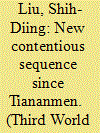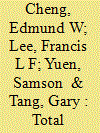| Srl | Item |
| 1 |
ID:
143560


|
|
|
|
|
| Summary/Abstract |
In the aftermath of the crackdown in Tiananmen, China’s political landscape has witnessed a new protest cycle. Unrest has escalated as a consequence of the reconfiguration of the Party-state, which has to deal with an increasingly restive society. The protest politics since the 1990s has unfolded with a set of distinctively different patterns, dynamics and consequences alongside with the transformation of the Party-state. This paper gives an account of the emerging new contentious sequence, with an emphasis on how the transformation of the Party-state has facilitated the conditions for popular resistance. The distinctiveness of the new sequence rests in the ambivalent relationship and strategic engagement with the decentralised Party-state, which has increasingly accommodated mass protest to recapture regime legitimacy. Profound changes in state governance and state–society linkages, the central–local divide, as well as the socialist tradition have all combined to reshape the conditions for contemporary popular struggle in China.
|
|
|
|
|
|
|
|
|
|
|
|
|
|
|
|
| 2 |
ID:
186936


|
|
|
|
|
| Summary/Abstract |
This article examines the origins and dynamics of an extraordinary wave of protests in Hong Kong in 2019–2020. Despite lacking visible political opportunities and organizational resources, the protest movement drew resilient, mass participation unparalleled in the city's history and much of the world. Drawing from original on-site surveys and online datasets, we conceptualize the Anti-Extradition Law Amendment Bill Movement as a form of “total mobilization from below.” The totality of the mobilization depended on a set of interactive mechanisms: abeyant civil society networks concealed after the 2014 Umbrella Movement were activated by threats over extradition and institutional decay, whereas affective ties developed through conflicts and mutual assistance were amplified by digital communication. The movement's characteristics in terms of protest scale, mobilizing structure, use of alternative spaces, and group solidarity are examined. The spasmodic moments of mobilization are explained by a nexus of network building that took place in an unreceptive environment and at a critical juncture. The roles of threats and emotions in mass mobilizations are also analysed.
|
|
|
|
|
|
|
|
|
|
|
|
|
|
|
|